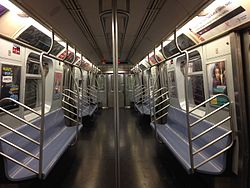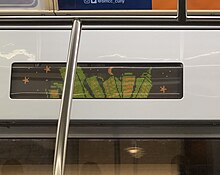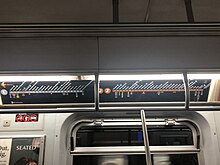R143 (New York City Subway car)
| R143 | |
|---|---|
 An R143 train on the L at New Lots Avenue | |
 Interior of an R143 car | |
| In service | 2001–present |
| Manufacturer | Kawasaki Rail Car Company |
| Built at | Yonkers, New York Lincoln, Nebraska Kobe, Japan |
| Family name | New Technology Train |
| Replaced | R40/As and R42s on the L route |
| Constructed | 2001–2003 |
| Entered service | December 4, 2001 (acceptance testing) February 12, 2002 (official service) |
| Number built | 212 |
| Number in service | 212 (192 in revenue service during rush hours) |
| Formation | 53 4-car sets (2 A cars and 2 B cars) |
| Fleet numbers | 8101–8312 |
| Capacity | 240 (A car) 246 (B car) |
| Operator(s) | New York City Subway |
| Depot(s) | East New York Yard[1] |
| Service(s) assigned | |
| Specifications | |
| Car body construction | Stainless steel with fiberglass rear bonnets |
| Train length | 4 car train: 240.84 feet (73.41 m) 8 car train: 481.68 feet (146.82 m) |
| Car length | 60.21 feet (18.35 m) |
| Width | 9.77 feet (2,978 mm) |
| Height | 12.13 feet (3,697 mm) |
| Platform height | 3.76 ft (1.15 m) |
| Doors | 8 sets of 50 inch wide side doors per car |
| Maximum speed | 55 mph (89 km/h) |
| Weight | A car: 83,700 lb (38,000 kg) B car: 81,900 lb (37,100 kg) |
| Traction system | Bombardier MITRAC propulsion system, 3-Phase IGBT-VVVF two-level AC Traction Motors Model 1508C, Pulse-width modulation |
| Prime mover(s) | Electric motor |
| Power output | 150 hp (111.9 kW) per axle |
| Acceleration | 2.5 mph/s (4.0 km/(h⋅s)) |
| Deceleration | 3.0 mph/s (4.8 km/(h⋅s)) (full service), 3.2 mph/s (5.1 km/(h⋅s)) (emergency) |
| Auxiliaries | SAFT 250AH battery (B car) |
| Electric system(s) | 600 V DC Third rail |
| Current collection method | Contact shoe |
| Braking system(s) | Dynamic braking propulsion system; WABCO RT96 tread brake system; safety brakes |
| Safety system(s) | CBTC, dead man's switch, tripcock |
| Headlight type | Incandescent light bulb |
| Track gauge | 1,435 mm (4 ft 8+1⁄2 in) standard gauge |
The R143 is a class of New Technology Train cars built by Kawasaki Rail Car Company for the New York City Subway's B Division. Delivered between 2001 and 2003, the cars displaced R40/As and R42s that operated on the L service in conjunction with the BMT Canarsie Line's signal system being automated.
The R143 was the first "B" Division order of the NTT series, and the first 60-foot (18.29 m) B Division car built for the New York City Subway system since 1969. A total of 212 cars were built, all arranged as four-car sets. First delivered in late 2001, they entered a 30-day period of revenue service testing on December 4, 2001, and officially entered service on the Canarsie Line on February 12, 2002. By March 2003, all cars had been delivered.
Description and features


The R143s are numbered 8101–8312. The 212 cars were expected to provide enough service for years, but the fast growth of the Williamsburg neighborhood overloaded the L by mid-2006.[3]
The R143s are the first 60-foot (18.29 m) B Division cars built for the New York City Subway system since the R42 from 1969, the first NTT model for the B Division, and the first automated fleet in the subway system. They are currently based at East New York Yard. The R143s are similar to the slightly newer R160s and R179s; however, the three car types are not interoperable with each other.[4]
Like the R142s, R142As, and R188s, the R143s feature electronic strip maps, depicting all stops on the L route. As of 2020, the R143s are being retrofitted with strip maps that show all stops on the L and J/Z routes. These newer installations depict the L and J/Z routes using two separate maps side-by-side, using the same 63-light console.
Unlike most NTT trains built between 1999–2019, the R143s are equipped with interior LED screens, which take the place of the MTA Arts for Transit cards that are usually located there. These screens can display advertisements, public safety announcements, and other information.[5] Several R160s were similarly retrofitted with LCD screens after they were delivered. However, the LCD screens on the R160s have the capability to display multiple colors instead of only red, orange, and green.
Communications-based train control
The Transit Authority had projected that 212 Kawasaki-made R143 subway cars would be enough to accommodate ridership demands for years to come, but ridership has risen higher than expected. Therefore, sixty-eight new R160A cars manufactured by Alstom were equipped with CBTC so they could run on the L along with the R143s.
History
Timeline of contract
The contract for the R143 was put out to tender in January 1998. The initial contract called for 100 sixty-foot cars that would come in five-car sets. The new cars would be expected to have automatic PA announcements, high efficiency lighting, emergency intercom and customer alarms, AC propulsion motors, speedometers and event recorders, electronic information display signs, artwork, a central diagnostics monitoring system, microprocessor-controlled air compressor, brake and communication systems, roof-mounted microprocessor-controlled HVAC, and to be compliant with ADA requirements.[6]
Kawasaki Rail Car Company was awarded a $190 million contract for 100 new B Division cars in late December 1998, with an option for 112 more cars.[7][8] The new design was based on the A Division's R142A, which Kawasaki also built,[9] and incorporated many features from the R110A and R110B prototypes. The cars were built with an average cost of about $1.5 million per car.
Delivery
Delivery of the cars began in late 2001. A 30-day revenue acceptance testing with one train of eight cars (8101–8108) began on December 4, 2001.[10][11] According to Kawasaki, the test was "extremely successful".[9] The cars began running on the Canarsie Line (L train) on February 12, 2002, where they have been assigned to.[12] All 212 cars were delivered by March 2003.[13]
Along with displacing older equipment from the Canarsie Line, the R143s also displaced the R42s on the now-extended weekend M shuttle service on the BMT Myrtle Avenue Line, when that line became the first BMT Eastern Division line to be placed in a weekend One Person Train Operation (OPTO) service. The R143s on the M were later displaced by the R160As in February 2008. OPTO service was also tested on the L during mid-2005, but it ended due to safety issues.[14][15]
Post-delivery
Cars 8205–8212 were originally delivered with experimental Siemens traction motors that would be later found in R160B cars 8843–9102. These cars were eventually refitted with the Bombardier MITRAC traction motors found on all other R143s.[16]
On April 18th, 2004, an eight-car R143 train overshot the bumper at Eighth Avenue after the operator suffered a possible seizure. The lead car, 8196, presumably suffered damage while the rest of the consist did not. [17] By 2007, it had been repaired and returned to service.
On June 21, 2006, another eight-car R143 train overshot the bumper, this time at the end of the tracks in the Canarsie Yard after the operator suffered a seizure. The first car, 8277, suffered significant damage and was stripped of damaged parts before being sent to the Kawasaki plant in Yonkers to receive repairs. The other cars in the set (8278–8280) suffered minor body damage and were moved to the 207th Street Yard and repaired. Eventually, 8277 was sent back to New York City Transit property and repaired. By 2016, car 8277 was finally recoupled with 8278–8280, but the consist needed component upgrades to become operational.[18] The set returned to service in December 2017.[a][better source needed]
In 2017, a set of R143s was equipped with measuring gauges to test out the curve radius and gangway flex in the existing 60-foot-long cars in order to collect data for evaluating the future R211T order.[b][better source needed]
In September 2020, the interior strip maps for these cars, which originally only depicted stops on the L route, were replaced with combined strip maps that includes stops on both the J/Z and L services; this follows a similar conversion that took place to the R142 strip maps on the 2/5 services between 2016 and 2018.
Notes and references
Notes
- ^ See also:
- MTA T Train (December 15, 2017), MTA NYC Subway J train leaving Van Siclen Ave, retrieved December 16, 2017
- ^ See also:
- Trains, DJH, "R211 Measurement Test Train Action (R143 Consist)", YouTube, retrieved September 4, 2020
References
- ^ "Car/Yard Assignments" (PDF). Archived from the original (PDF) on December 5, 2019.
- ^ "Subdivision 'B' Car Assignments: Cars Required April 27, 2020" (PDF). The Bulletin. Electric Railroaders' Association. 63 (6): 14. June 2020. Retrieved June 1, 2020.
- ^ New York Daily News, Oh, L, not enuf trains!, July 7, 2006
- ^ Chan, Sewell (November 30, 2005). "New Subway Cars Promise All Kinds of Information". The New York Times. Retrieved October 27, 2007.
- ^ "Showing Image 3648". www.nycsubway.org. Retrieved April 25, 2018.
- ^ "R34143 PURCHASE 100 CARS DIVISION 'B' OVER $10M". www.mta.nyc.ny.us. New York City Transit. January 27, 1998. Archived from the original on January 27, 1998. Retrieved September 18, 2016.
- ^ "Metro Business; Subway Job to Kawasaki". The New York Times. December 30, 1998.
- ^ Kawasaki wins new NYCT car order The Railway Age February 1999 page 23
- ^ Jump up to: a b Kawasaki, New York City Transit R143 Subway Cars Archived April 27, 2007, at the Wayback Machine, accessed April 14, 2007
- ^ "www.nycsubway.org".
- ^ "First run of the R143s". New York Division Bulletin. Electric Railroaders' Association. January 2002.
- ^ Kennedy, Randy (July 31, 2002). "1,700 Subway Cars to Be Built Under Largest Such Contract in New York History". The New York Times. p. B3.
- ^ "Kawasaki completes NYCT R143 order. (Market).(New York City Transit)(subway cars contract)". Railway Age. HighBeam Research. March 1, 2003. Archived from the original on February 20, 2016.
- ^ On L Train, Drivers Perform Solo, Without Conductors, June 20, 2005, page B3
- ^ Conductors Are Returning to the Subway's L Line
- ^ Samsone, Gene (October 25, 2004). New York Subways: An Illustrated History of New York City's Transit Cars. Baltimore, MD: JHU Press. p. 282. ISBN 0801879221.
- ^ "L train hits 8th Av bumper block, 2004".
- ^ "New York City Subway Car Update" (PDF). The Bulletin. Electric Railroaders' Association (April 2016). March 30, 2016. Retrieved March 30, 2016.
External links
| Wikimedia Commons has media related to R143 (New York City Subway car). |
- nycsubway.org - R143
- Korman, Joe (January 12, 2018). "BMT-IND Car Assignments". JoeKorNer.
- Korman, Joe (November 6, 2016). "New York City Subway Car Fleet June 2010 through November 2016". JoeKorNer.
- Kawasaki Rail Car Company
- Kawasaki multiple units
- New York City Subway rolling stock
- Train-related introductions in 2001

